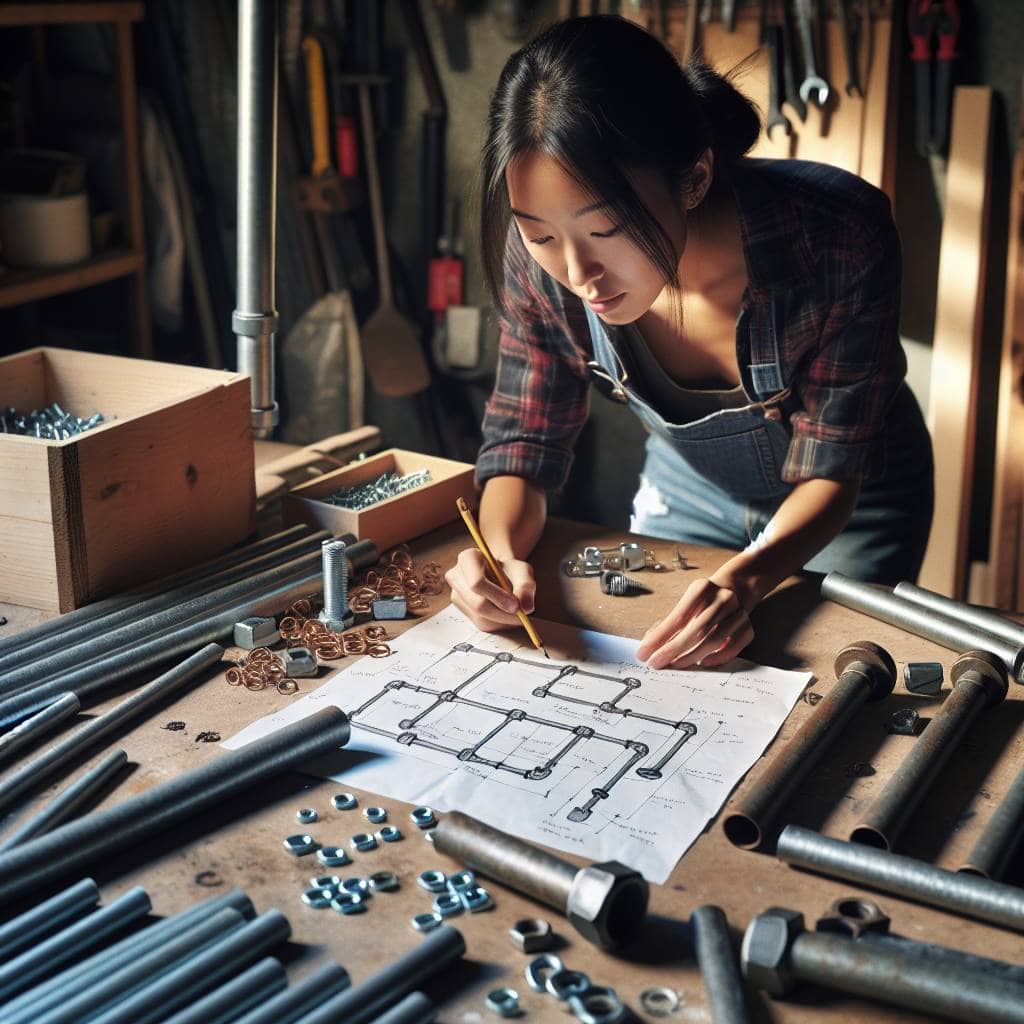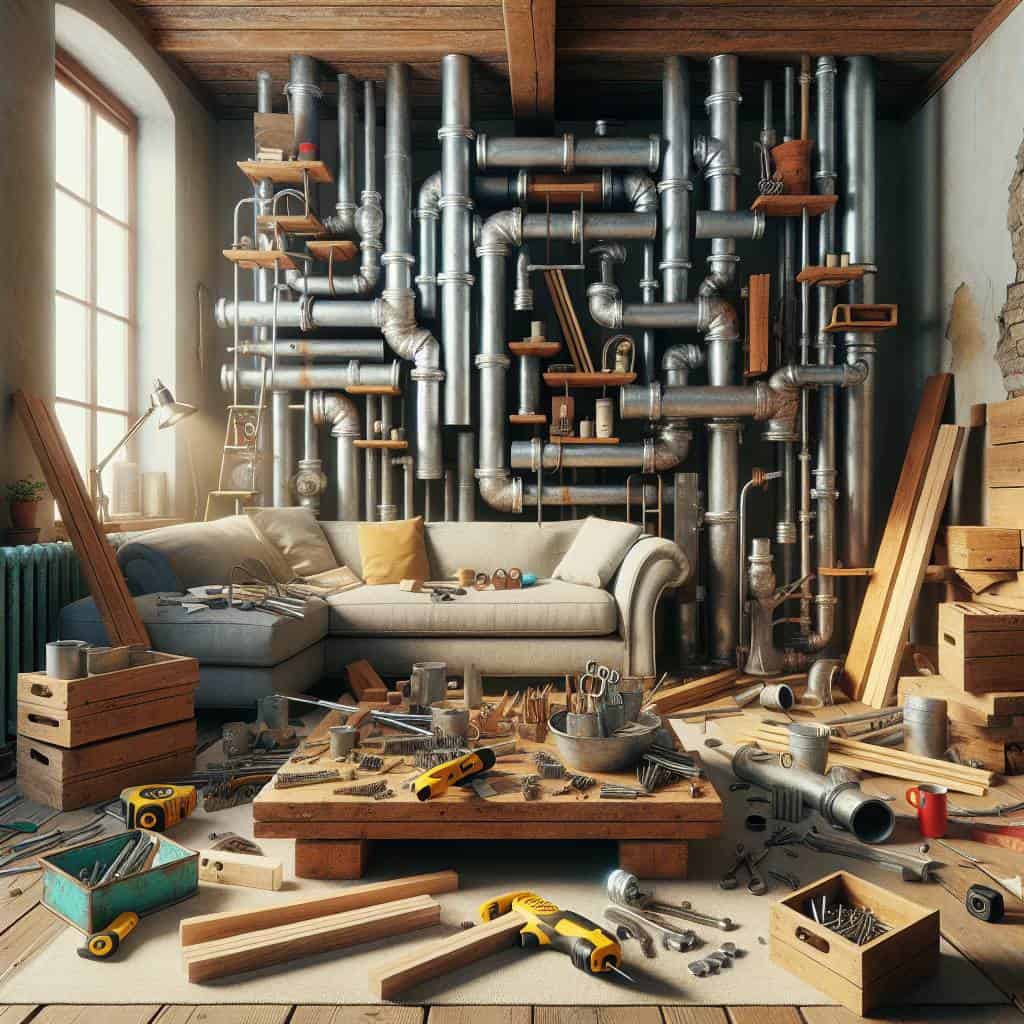They say tackling a DIY project is therapeutic, a way to unwind from the daily grind. But when I decided to build an industrial pipe bookshelf, it felt less like therapy and more like signing up for an elective in frustration management. Picture this: me, standing in my garage, surrounded by a sea of metal pipes that seem to have a mind of their own, and a plan sketched on a napkin that made more sense after a couple of beers. If you’ve ever attempted to turn a bunch of mismatched fittings and a slab of wood into a functional piece of furniture, you know exactly where I’m coming from. It’s like trying to assemble IKEA furniture without the instructions—just you, a wrench, and a prayer.

So, you’re deep into this project, pondering the existential mystery of fitting pipes and planks into a coherent bookshelf. And as you sit there, surrounded by a metallic chaos, you might find yourself yearning for a little distraction. That’s where I found something interesting. While you’re waiting for the paint to dry or just need a mental break from all the DIY madness, why not check out the most interesting adult chatting platform in Germany, Geile Weiber? It’s a place where you can chat with local ladies and take your mind off the nuts and bolts for a while. Trust me, a little diversion can be just what the mechanic ordered to keep your sanity intact during such projects.
But here’s the deal. If you’re ready to dive into this madness, I’m here to guide you through the chaos. In this article, I’ll walk you through the nitty-gritty of gathering the right parts, cutting and prepping the wood, and piecing it all together without losing your marbles. We’ll delve into design ideas that won’t make your living room look like a steampunk convention gone wrong. So, roll up your sleeves, because we’re about to transform that pile of metal and wood into something that not only holds books but holds its ground in style.
Table of Contents
- When Pipes and Planks Collide: The Tale of My Shelf Saga
- Fittings: The Tiny Tyrants of My Workshop
- Wood: From Lumber Yard to Living Room
- How I Turned My Living Room into a Pipe Wonderland
- Lessons Learned from Wrestling with Metal and Wood
- From Chaos to Craft: The Art of Pipe Shelving
- Pipe Dreams: Your Burning Questions Answered
- The Final Turn of the Wrench
When Pipes and Planks Collide: The Tale of My Shelf Saga

I never imagined my living room would resemble a hardware store’s back alley, pipes and planks strewn about like a mad inventor’s playground. But that’s exactly what happened when I decided to build my own industrial pipe bookshelf. The first thing I learned? Patience is key. And maybe a bit of humor, too. You see, when pipes and planks collide—literally—it’s about more than just getting the right measurements. It’s about juggling fittings that refuse to cooperate and wood that seems to have a personality of its own. Each piece has a role in this complex dance, and getting them to work together is like setting up an awkward blind date between two stubborn partners.
The real trick was in the design. I had to imagine where each shelf would sit, suspended between the cold, hard steel and the warmth of the wood. It was an exercise in balance—both structurally and aesthetically. Every fitting had to be meticulously tightened, every plank carefully measured and cut. Of course, there were moments when I thought I might lose my mind, like when the last plank didn’t quite fit, and I had to break out the saw again. But that’s the beauty of it. Building this shelf was a saga of trial and error, a testament to perseverance and the satisfaction of crafting something with my own two hands. When it all came together, I stood back and admired my creation, a fusion of industrial grit and rustic charm that told a story all its own.
Fittings: The Tiny Tyrants of My Workshop
If you’ve ever tangled with pipe fittings, you know they’re the workshop equivalent of a mischievous gremlin. These tiny tyrants come in all shapes and sizes, each with its own mind-boggling purpose. Flanges, elbows, tees; they sound more like a circus troupe than a collection of metal parts. As I laid them out across my workbench—or should I say, the battlefield—I realized these seemingly innocuous pieces held the power to make or break my shelf saga. And let me tell you, they were bent on breaking it.
Every time I thought I had the right fitting in hand, it turned out to be the wrong thread or the wrong angle. It’s like they were conspiring, laughing at my expense. One minute, I’m feeling like a genius engineer ready to revolutionize my living room; the next, I’m a hapless tinkerer, cursing under my breath. But with each wrong turn, I learned their tricks and quirks. Slowly, I managed to tame these tyrants, turning chaos into order, and finally, those pipes and planks began to dance to my tune.
Wood: From Lumber Yard to Living Room
Picture this: I’m at the lumber yard, surrounded by a forest of timber, trying to pick out the perfect plank for my latest creation. You’d think wood is just wood, right? Wrong. It’s like picking a pizza topping—you’ve got options, and each brings its own flavor. I’m not just grabbing any old board; I’m hunting for that piece with the right grain, the right color, and, most importantly, the right story. Trust me, these planks have tales to tell. I’m looking for the one that’s going to survive the journey from the dusty yard to the heart of my living room, where it’ll transform into a centerpiece that’s not just functional but a conversation starter.
Once I’ve made my choice, I haul that wood back home, and the real magic begins. This is where the lumber yard’s dusty promise turns into reality. The process isn’t glamorous. Sanding, cutting, and drilling—each step is a rite of passage for that piece of wood. I’ll be honest, it’s a bit like a wrestling match, me against the wood, each trying to impose our will. But when it finally slots into place on that shelf, nestled between the industrial pipes, it’s like seeing my efforts come to life. It’s not just a piece of furniture; it’s a testament to the journey, from yard to living room, with a little bit of elbow grease and a lot of heart.
How I Turned My Living Room into a Pipe Wonderland
- First, embrace the chaos: your floor is about to become a sea of pipe fittings and wood planks—call it industrial chic in progress.
- Get your hands on some solid wood shelves; think of them as the backbone that’ll hold your literary treasures, not just a place to dump your spare change.
- When picking fittings, remember—they’re like the unsung heroes of your design. Go for galvanized steel if you want that gritty, industrial vibe.
- Assemble with intention: this is your chance to channel your inner architect without the fancy degree—measure twice, cut once, and don’t forget the elbow grease.
- Play with the design. Your bookshelf doesn’t have to be just a shelf; it’s a statement piece, a testament to your DIY prowess and a nod to functional art.
Lessons Learned from Wrestling with Metal and Wood
Embrace the Chaos: Your workspace will look like a scrapyard exploded. Accept it. Pipe fittings will roll under furniture, and wood shavings will find their way into every crevice of your home. It’s all part of the charm.
Measure Twice, Cut Once: This isn’t just some old carpenter’s tale. When you’re dealing with industrial pipes and shelves, precision is your best friend. A misaligned pipe is a bookshelf that leans like it’s had one too many.
Design with Intention: Before you start drilling and hammering, sketch out your vision. Know where each shelf will sit and how it will hold up under the weight of your favorite books or decor. A little planning goes a long way in preventing mid-project panic.
From Chaos to Craft: The Art of Pipe Shelving
Building an industrial pipe bookshelf isn’t just about fitting pipes and wood together. It’s about turning the chaos of scattered fittings into a symphony of design and function. Every piece, every screw, every shelf—it’s your creation, your story, your masterpiece.
Pipe Dreams: Your Burning Questions Answered
What kind of pipe fittings do I need for my bookshelf?
Think of pipe fittings as the joints in your bookshelf’s skeleton. You’ll need elbows, tees, and flanges. Go for black iron if you want that rugged industrial look. Just be ready for a bit of grease—these bad boys are as industrial as it gets.
How do I choose the right wood for the shelves?
The wood sets the tone. Want something rustic? Opt for reclaimed wood—it’s got character and a story. Prefer sleek? Go for a polished hardwood like oak or maple. Just make sure it’s sturdy enough to hold your prized collection of… whatever it is you collect.
How can I make sure everything stays in place during assembly?
Gravity is your friend, but don’t rely on it alone. Secure those shelves by anchoring the flanges into the wall studs. And remember, nothing says ‘I built this’ like a level bookshelf. Keep a level handy, and don’t be afraid to adjust as you go.
The Final Turn of the Wrench
So here we are, at the end of this whirlwind of metal and wood. I’ve got sawdust in my hair and a deep appreciation for anyone who ever looked at a pile of pipes and thought, ‘Yeah, I can make something out of that.’ It’s not just about slapping things together; it’s a dance of balance and precision, like tuning an engine to purr just right. Each shelf wasn’t just a piece of wood; it was a canvas for my ideas, a testament to the countless times I had to rethink and adjust, wrench in hand, sweat on brow.
In the end, it’s more than just a bookshelf—it’s a piece of me, a symphony of fittings and planks. Each joint and beam tells its own story, a reminder that sometimes the most rewarding creations come from a bit of chaos and a lot of determination. Looking at it now, standing proud and sturdy, it’s more than furniture. It’s a nod to my stubborn resolve and the joy of transforming raw materials into something that’s part of my home, a testament to what a pair of hands and a determined spirit can achieve. Next time I’ll probably wear gloves. Or maybe not.